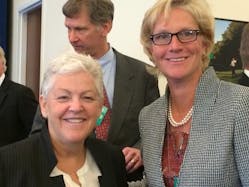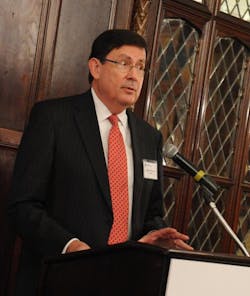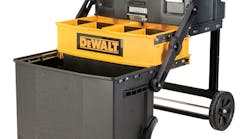Johnson Controls
“We applaud the Administration and the regulatory agencies for taking a collaborative approach with industry to manage the phase-down in use of HFCs,” said Laura Wand, vice president, chiller solutions, at Johnson Controls’ Building Efficiency business. “ At the event, Johnson Controls spoke up about the importance of considering the energy efficiency of the system when selecting a new refrigerant, not just its low global warming potential. Up to 98% of the total CO2 equivalent emissions over the life of air conditioning equipment can be due to energy use alone, not the global warming potential of the refrigerant contained. According to Wand, some new refrigerants being released on the global market can in fact lower equipment efficiency, which will have a negative impact on the environment.
“The energy efficiency makes the greatest impact on the total carbon-footprint of a system over its life,” Wand said. “Therefore, when making choices on refrigerants, we cannot sacrifice energy efficiency.”
Contractor end-users will be pleased to know Johnson Controls has advocated for the interests of its customers during discussions with industry associations and legislators on the regulations and standards related to refrigerants. Sources say the refrigerants that it chooses for its products will best fit the needs of its customers and the environment based on safety, energy efficiency, reliability, availability and cost. The company has already spent more than $26 million over the past 3 years in the development of low global warming potential technologies.
DuPont
DuPont representatives brought messages related to company history, the need to reduce emissions, and DuPont’s solutions.
“DuPont welcomes the opportunity to participate in today’s White House Roundtable regarding hydrofluorocarbons (HFCs). DuPont has for almost 85 years been an innovator in refrigerants and insulating foam products, including HFCs, that have provided critical societal services such as refrigeration, air conditioning and energy efficiency while steadily improving the safety of these applications,” said Kathryn K. McCord, global business director, DuPont Fluorochemicals.
“DuPont innovations have shown a steady reduction in impact to the ozone layer and climate, from CFCs to HCFCs, to HFCs and now to the new HFOs. DuPont also played a leading role in the development and implementation of the Montreal Protocol, the world’s most effective global environmental treaty. Under the Montreal Protocol the world has successfully addressed the threat of ozone depletion by phasing down the use of the previous generations of refrigerants, culminating in today’s generation of refrigerants, the non-ozone depleting HFCs,” McCord continued.
DuPont reports its new Opteon XP40 is showing similar efficiency gains in commercial refrigeration, significantly reducing power consumption and related carbon dioxide (CO2) emissions, and a new refrigerant under development is showing substantial promise in improving industrial energy efficiency by capturing and recycling waste heat.
Hillphoenix
Hillphoenix President/CEO Paul Sidoni was in attendance at the meeting, which was organized by the Council on Environmental Quality.
“We appreciate being invited into the discussion about how to curb emissions in ways that are good for business and the environment,” Sidoni said. “Hillphoenix is committed to developing responsible solutions that provide operational savings for our food retailers and environmental benefits for the communities they serve.”
In 1995, Hillphoenix introduced one of the industry’s first emissions-reducing coolant technologies. Since then, according to sources, it has been a leader in moving sustainable refrigeration technologies to the market, and helping supermarkets keep pace with regulatory changes. Hillphoenix’s environmental improvements in alternative refrigerants and energy efficiency have removed more than 2 billion pounds of harmful emissions from the atmosphere since the mid-1990s.
Recently, Hillphoenix, in partnership with Sprouts Farmers Market, unveiled a refrigeration system that eliminates the use of HFCs, even in warm climates (bit.ly/hpsproutsstore). In addition, the company’s “Close the Case” initiative, which puts energy-saving doors on open refrigerated display cases, has helped grocers cut case energy consumption by 70%.
Honeywell: Cutting HFCs Over 5 Years
Sources for Honeywell announced during the meeting that it will increase production of its low-global-warming-potential (GWP) refrigerants, insulation materials, aerosols and solvents, and, prior to 2020, will drive a 50% reduction in its annual production of high-GWP hydrofluorocarbons (HFCs) on a CO2 equivalent basis.
Honeywell has already reduced its CO2-equivalent fluorocarbon production by 30% since 2007 by converting legacy production assets to low-global-warming technologies. The company plans to reduce CO2-equivalent production of HFCs by an additional 50% over the next five years as customers throughout the world adopt new LGWP products to reduce greenhouse gas emissions, increase energy efficiency and meet proposed tighter U.S. Environmental Protection Agency (EPA) regulations.
“Regulators around the world are taking steps to address climate change, and Honeywell is an industry leader in this area with technologies that significantly reduce greenhouse gas emissions and an array of technologies that promote energy efficiency and cleaner energy production,” said Darius Adamczyk, president and chief executive officer of Honeywell Performance Materials and Technologies.
Daikin/Goodman: R-32 Availability
Daikin and its Goodman division were also represented, by aims to reduce its greenhouse gas emissions in 2020 to one-quarter of its 2005 emissions. The manufacturer plans to introduce a full product line of lower-GWP refrigerant air conditioners and heat pumps, after working with the EPA and other stakeholders to permit these refrigerants in both building codes and the Clean Air SNAP program.
“Daikin and Goodman are taking an aggressive, leading role to expedite the adoption of safety codes and standards that establish reasonable requirements for the use of lower-GWP alternatives to replace the high-GWP substances now in use throughout our industry,” explained Takeshi Ebisu, president and CEO of Daikin North America.
In addition, Daikin is opening its basic technology patents of R-32, a Daikin-developed refrigerant that significantly reduces climate impacts from the air conditioning sector. This allows any company to use R-32 without payment of royalties for manufacturing in developing countries. In the U.S., Daikin will permit any company to use its R-32 basic technology patents without the payment of royalties for manufacturing, provided that the company using the patents offers Daikin the use of an equal number of that company’s patents without payment of royalties.
R-32’s global warming potential is two-thirds less than the substances it will replace. The company says that enabling large-scale introduction of R-32 air conditioning products in the U.S. can reduce CO2–equivalent greenhouse gas emissions by up to 75% in the air conditioning sector, compared to the emissions from current technology.
While rarely found in the U.S., R-32 technology is rapidly gaining worldwide acceptance. Since November 2011, several companies have sold almost three million R-32 ductless air conditioners in Japan, and there are increasing numbers of R-32 air conditioner sales in India and Europe.
“The proliferation of R-32 air conditioners worldwide, including in the U.S., will result in a substantial reduction in direct and indirect climate impacts from the air conditioning industry,” said Ebisu.
Danfoss: Task Force is Meeting
Danfoss announced its commitment to convening and facilitating an on-going Codes and Standards Task Force, which will set out to define a roadmap that will accelerate implementation of low-GWP refrigerants.
“State and local fire and building codes are major barriers to the broad deployment and adoption of low-GWP refrigerants in the United States,” explained John Galyen, president, Danfoss North America. “These codes often prohibit the use of flammable or even mildly flammable refrigerants, even in very small amounts less than a typical aerosol spray can. Since they are developed and mandated locally – across hundreds or thousands of jurisdictions, codes are difficult to change and create an effective obstacle to manufacturers offering products with low-GWP refrigerants that may be flammable or mildly flammable.”
“Much work also is needed to modify underpinning national model codes and standards before local standards can be changed,” Galyen continued. “The issue is complex and requires a sequential nature of modifying standards and codes, as well as broad industry training.”
The task force facilitated by Danfoss will be composed of a broad, cross-section of experts from industry, environmental NGOs, U.S. Environmental Protection Agency, UL, fire marshals, and other stakeholders with an interest in collaboration and defining the path forward.
Since July, Danfoss has hosted three meetings to launch the Codes and Standards Task Force, most recently on September 12.












